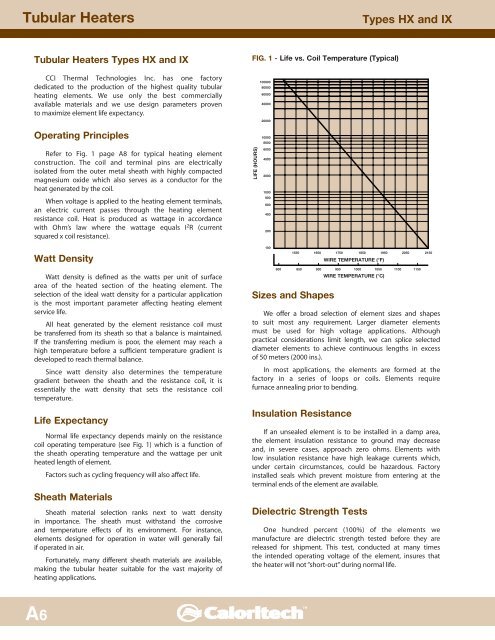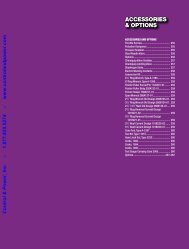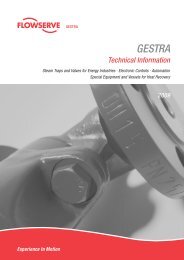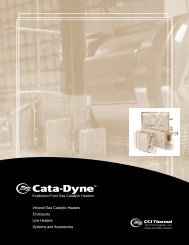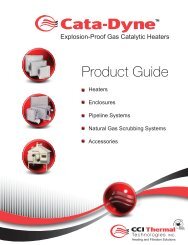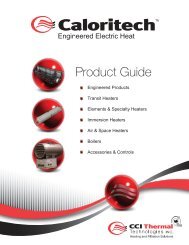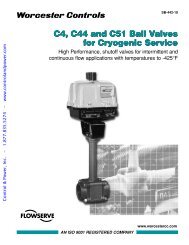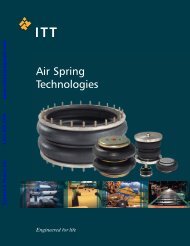Engineered Electric Heat - Control And Power
Engineered Electric Heat - Control And Power
Engineered Electric Heat - Control And Power
You also want an ePaper? Increase the reach of your titles
YUMPU automatically turns print PDFs into web optimized ePapers that Google loves.
Tubular <strong>Heat</strong>ers<br />
A<br />
Tubular <strong>Heat</strong>ers Types HX and IX<br />
CCI Thermal Technologies Inc. has one factory<br />
dedicated to the production of the highest quality tubular<br />
heating elements. We use only the best commercially<br />
available materials and we use design parameters proven<br />
to maximize element life expectancy.<br />
Operating Principles<br />
Refer to Fig. 1 page A8 for typical heating element<br />
construction. The coil and terminal pins are electrically<br />
isolated from the outer metal sheath with highly compacted<br />
magnesium oxide which also serves as a conductor for the<br />
heat generated by the coil.<br />
When voltage is applied to the heating element terminals,<br />
an electric current passes through the heating element<br />
resistance coil. <strong>Heat</strong> is produced as wattage in accordance<br />
with Ohm’s law where the wattage equals I 2 R (current<br />
squared x coil resistance).<br />
Watt Density<br />
Watt density is defined as the watts per unit of surface<br />
area of the heated section of the heating element. The<br />
selection of the ideal watt density for a particular application<br />
is the most important parameter affecting heating element<br />
service life.<br />
All heat generated by the element resistance coil must<br />
be transferred from its sheath so that a balance is maintained.<br />
If the transferring medium is poor, the element may reach a<br />
high temperature before a sufficient temperature gradient is<br />
developed to reach thermal balance.<br />
Since watt density also determines the temperature<br />
gradient between the sheath and the resistance coil, it is<br />
essentially the watt density that sets the resistance coil<br />
temperature.<br />
Life Expectancy<br />
Normal life expectancy depends mainly on the resistance<br />
coil operating temperature (see Fig. 1) which is a function of<br />
the sheath operating temperature and the wattage per unit<br />
heated length of element.<br />
Factors such as cycling frequency will also affect life.<br />
Sheath Materials<br />
Sheath material selection ranks next to watt density<br />
in importance. The sheath must withstand the corrosive<br />
and temperature effects of its environment. For instance,<br />
elements designed for operation in water will generally fail<br />
if operated in air.<br />
Fortunately, many different sheath materials are available,<br />
making the tubular heater suitable for the vast majority of<br />
heating applications.<br />
FIG. 1 - Life vs. Coil Temperature (Typical)<br />
LIFE (HOURS)<br />
100000<br />
80000<br />
60000<br />
40000<br />
20000<br />
10000<br />
8000<br />
6000<br />
4000<br />
2000<br />
1000<br />
800<br />
600<br />
400<br />
200<br />
100<br />
Sizes and Shapes<br />
We offer a broad selection of element sizes and shapes<br />
to suit most any requirement. Larger diameter elements<br />
must be used for high voltage applications. Although<br />
practical considerations limit length, we can splice selected<br />
diameter elements to achieve continuous lengths in excess<br />
of 50 meters (2000 ins.).<br />
In most applications, the elements are formed at the<br />
factory in a series of loops or coils. Elements require<br />
furnace annealing prior to bending.<br />
Insulation Resistance<br />
If an unsealed element is to be installed in a damp area,<br />
the element insulation resistance to ground may decrease<br />
and, in severe cases, approach zero ohms. Elements with<br />
low insulation resistance have high leakage currents which,<br />
under certain circumstances, could be hazardous. Factory<br />
installed seals which prevent moisture from entering at the<br />
terminal ends of the element are available.<br />
Dielectric Strength Tests<br />
One hundred percent (100%) of the elements we<br />
manufacture are dielectric strength tested before they are<br />
released for shipment. This test, conducted at many times<br />
the intended operating voltage of the element, insures that<br />
the heater will not “short-out” during normal life.<br />
<strong>Engineered</strong> <strong>Electric</strong> <strong>Heat</strong><br />
1550 1650 1750 1850 1950 2050 2150<br />
WIRE TEMPERATURE (°F)<br />
800 850 900 950 1000 1050 1100 1150<br />
WIRE TEMPERATURE (°C)<br />
Types HX and IX


